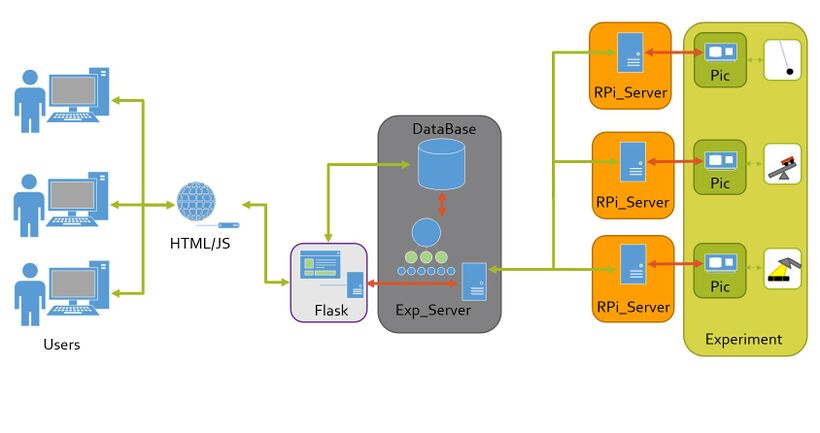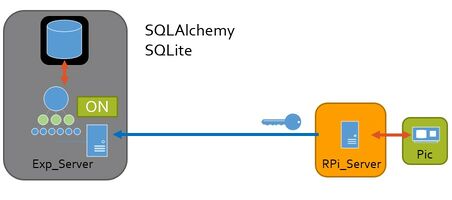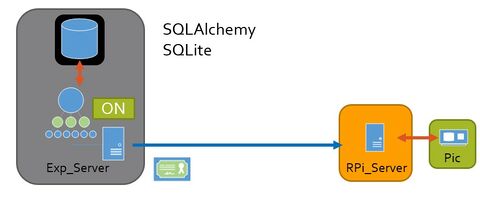FREE - Framework for Remote Experiments in Education
Contents
System architecture
In the defined architecture, users communicate with a central server, named Main_Server, through web pages.
This Main_Server server contains the database with the results of the experiments already carried out and the experimental executions and experimental time schedules requested by users through the web interface. The Main_Server server is also responsible for mediating real-time communication between users and experiences, exchanging configuration requests, status requests and responses and generated data between users actively connected to the apparatus and apparatus.
Along with the experimental apparatus, a computer, named RPI_Server, acts as an interface between the controller of the experimental apparatus and the Main_Server server. Each RPI_Server is turned on and represents one, and only one, experimental apparatus. It is important to note that this component was named RPI_Server because it is, in principle, implemented through the use of a Raspberry Pi, a computer that has communication modules necessary to communicate natively with the microcontrollers usually used to control the devices. However, this component can be implemented in other ways and it is only strictly necessary that it communicates according to the protocol - e.g. a virtual experience with data generated through a numerical model can implement this component with a normal computer without specialized interfaces. The communication between all components is done over the internet, with the exception of the communication between the RPi_Server and the experimental apparatus, where communications are made through the protocol that the controller of the apparatus implements.
Communication protocol
To start the connection between the RPi_Server and the Main_Server, when the RPi_Server is turned on, it tries to connect to the Main_Server server. If not successful, it should wait 10 seconds and try again until it manages to make the connection.
When the connection is successfully established, the server RPi_Server sends to Main_Servero its ID and Secret. These two variables are then checked on the Main_Server server side as a simple way to authenticate that the connection is coming from an authorized machine. In case of successful verification, the Main_Server responds to the RPi_Server with a message encoded in JSON format that describes the experience to be served by the RPi_Server. This configuration message allows the same RPi_Server program to be adaptable to different experiences with, for example, different numbers of actuators and sensors without changes to the source code. Based on the information contained in this message, the name of the config_file, the RPi_Server looks for the experiment at the indicated address and tries to establish communication with the controller of the experimental apparatus. In order to decouple the RPi_Server from the different communication protocols that each experimental controller may implement, the RPi_Server must communicate with the devices calling a set of standard methods whose implementation must be adapted to suit the target controller.
(TODO)
After this initial configuration, the connection of the RPi_Serverao Main_Serverand the RPi_Serverto the controller of the experiment, the system is ready for the exchange of messages between the components. The messages exchanged between components were defined following an everything is a string philosophy. Thus, the messages exchanged are JSON-formatted strings in which the JSON fields encode the message to be transmitted. The type of each message is identified by the msg_id field of the message JSON, and for the message sent, the reply, if any, must have reply_id with the same value. In order to be adaptable to various types of experimental apparatus, the system does not store apparatus status information so it is possible to send any of the defined messages at any time. The correct sequencing of messages for the successful operation of the apparatus is the responsibility of other user-controlled software layers.
Functions documentation
Main_Server
RPi_Server
interface.py(RPi_Server)
How to install
Pre-requisites
Build environment
- Git (2.30.2+)
- Python (3.7.0+)
Raspberry PI (RPI_Proxy)
First checkout the project from github (https://github.com/e-lab-FREE/RPi_Server-PG), and you can get the code using:
$ git clone https://github.com/e-lab-FREE/RPi_Server-PG
then edit the "main.py" file and change the following global variables:
SERVER = "main_server_IP" MY_IP = "RPi_IP" SEGREDO = "password" PORT = Port_to_comunication BINARY_DATA_PORT = Port_to_transfer_Binary_data
After this changes the RPi_Server is ready to run by typing:
$ pyhton3 main.py
This will try to connect to the IP defined as SERVER every 10 sec.
Main Server (Main_Server)
This software is the dispatcher of the information. By allowing the communications form the frontend and each RPi_Server responsable for a experience. To install this you need to install at least Python 3.7 and the lib Flask (https://pypi.org/project/Flask/).
Then go to the project from github:
$ git clone https://github.com/e-lab-FREE/Main_Server
Edit the "main.py" file and change the following global variables:
SERVER = "main_server_IP" MY_IP = "RPi_IP" SEGREDO = "password" PORT = Port_to_comunication BINARY_DATA_PORT = Port_to_transfer_Binary_data
After that you need to change or edit this last one variable "segredos",
the struct of it's the following:
{
"RPi_IP" :
{
"segredo": "password",
"nome": "Name_of_the_exp"
},
...
}
Config File (JSON)
In the project of the Main_Server there is a folder called Configs, in there are all the configuration files of the experience linked to the Main_Server. To add a new experiment you just have to copy one of the existing files and change its name to the experiment's and change the parameters in the config file:
After this changes done you can run the Main_Server, typing the cmd:
$ start.bat
Video Streaming
Intro
Video capture and stream
On the raspberry it is running ....
Janus stream server
Accessing the stream
The experiment stream can be access by a html ....
or by using VLC, allowing to grab the video




